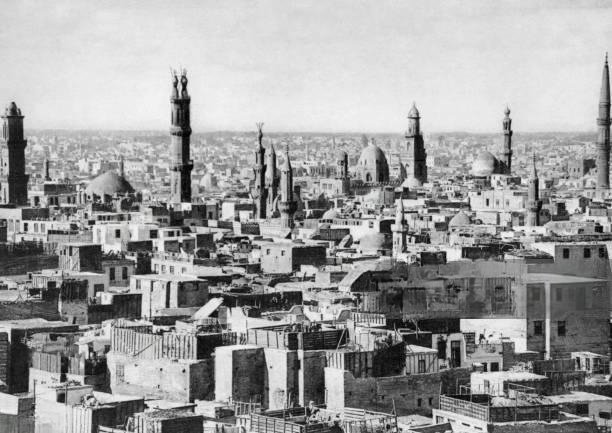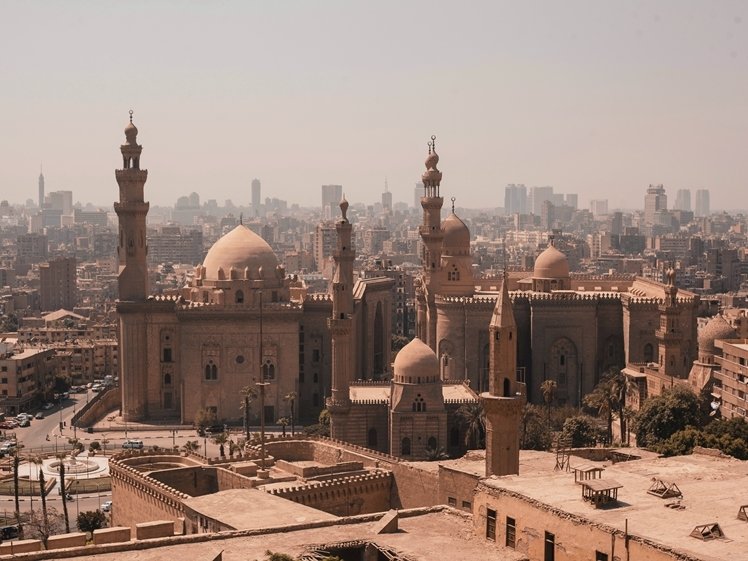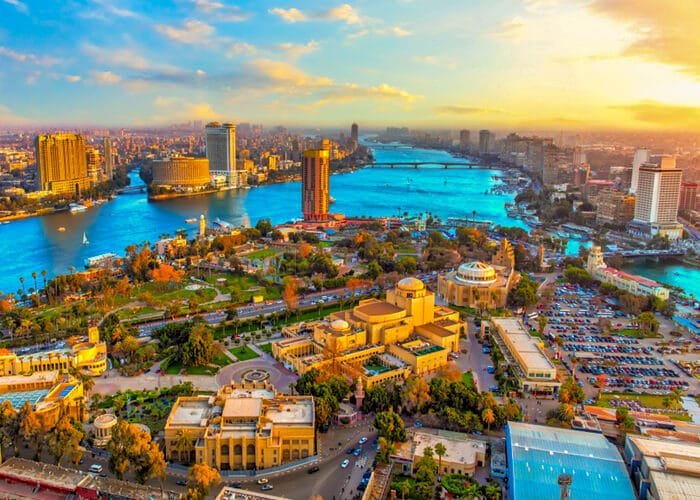Cairo Then and Now
Cairo Then
Cairo, the capital of Egypt, is not only one of Africa’s largest cities but also a hub of rich historical and cultural significance.
Its roots trace back to ancient Egypt, with landmarks like the Giza pyramid complex, and the ancient cities of Memphis and Heliopolis situated nearby.
Initially developed as Fustat after the Muslim conquest of Egypt in 641, Cairo grew around the Roman fortress of Babylon.
It was later established as a major urban center by the Fatimid dynasty in 969 and gradually replaced Fustat during the Ayyubid and Mamluk periods.
Often referred to as “the city of a thousand minarets” due to its stunning Islamic architecture, Cairo became a beacon of political and cultural influence in the region.
Its historic center, recognized for its significance, was designated a UNESCO World Heritage Site in 1979.

The city’s name, al-Qāhirah, meaning “the Vanquisher” or “the Conqueror,” was chosen by the Fatimid Caliph al-Mu’izz, and is thought to be influenced by the rise of the planet Mars, symbolizing conquest.
Today, Cairo remains a World City with a “Beta+” classification, reflecting its continued importance on the global stage.
Related Article: Denver Then and Now
Cairo History
Cairo, Egypt’s bustling capital, has evolved from a series of ancient settlements into one of the most important cities in the Middle East and North Africa.
The city’s origins can be traced back to Memphis, a thriving metropolis about 5,000 years ago, which today lies mostly in ruins near Cairo.
Two millennia later, the Romans established a settlement called Babylon on Cairo’s current site.
However, Cairo’s modern story began in 641 CE when the Arab general ʿAmr ibn al-ʿĀṣ founded the town of Al-Fusṭāṭ as a military encampment.
Related Article: Seattle Then and Now
Over time, the city grew with the establishment of royal suburbs by various dynasties, including the Umayyads and the Ṭūlūnids, marking its development into a commercial and industrial hub.
Significant remnants from these periods still remain, such as the historic mosques of ʿAmr ibn al-ʿĀṣ and Aḥmad ibn Ṭūlūn.
In 969 CE, the Fatimids, a Shiʿi dynasty, conquered Egypt and established Cairo as their new capital.
The city was initially named Al-Manṣūriyyah but was later renamed Al-Qāhirah, meaning “The Victorious,” in honor of the Fatimid caliph al-Muʿizz.
Related Article: Dallas Then and Now
The Fatimids’ reign marked the beginning of Cairo’s prominence, and the city’s architectural and cultural landscape flourished.
In 1168, Al-Fusṭāṭ was set ablaze to prevent its capture by Crusaders, solidifying Cairo as the dominant urban center.
Under the rule of Saladin in the 12th century, Cairo’s infrastructure expanded, including the construction of the Citadel and the extension of its city walls.
By the 14th century, Cairo reached its peak during the Mamluk era, becoming the largest city in Africa, Europe, and Asia Minor, with a population nearing half a million.
Related Article: Miami Then and Now

However, Cairo’s fortunes began to decline in the late 14th century due to a series of devastating plagues, including the Black Death, and the disruption of the spice trade following European exploration.
By 1517, Cairo had lost its political autonomy and became part of the Ottoman Empire.
Despite these setbacks, Cairo remained a cultural and intellectual center.
The 19th century saw the introduction of European institutions, including theaters and opera houses, marking the city’s cultural renaissance.
Related Article: Washington D.C. Then and Now
Cairo became a significant hub for Arab cinema, music, and media, with Egyptian film and radio reaching audiences across the Arab world.
Cairo is also home to a number of museums and historical sites that showcase its rich cultural heritage.
The Egyptian Museum in Tahrir Square is famous for its vast collection of ancient Egyptian antiquities, while the Coptic Museum focuses on the Christian history of Egypt.
The Museum of Islamic Art and the Museum of Modern Egyptian Art further highlight Cairo’s diverse historical and artistic influences.
Related Article: Boston Then and Now
The city’s mosques, such as the Al-Azhar Mosque, are architectural treasures and contribute to Cairo’s nickname, “the city of a thousand minarets.”
Modern Cairo, with its thriving media, bustling markets, and growing infrastructure, remains an influential cultural and political center in the Arab world.
Its numerous parks, zoos, and recreational spaces, including the Cairo Zoological Gardens and the Cairo Stadium, offer a blend of nature and entertainment.
The city continues to captivate visitors with its unique blend of ancient history and modern development, making it one of the most dynamic cities in the world.
Related Article: San Francisco Then and Now
Cairo Now

Cairo, the capital and largest city of Egypt, serves as both the political and cultural heart of the nation.
With a population of over 10 million people, Cairo is the largest city in both Africa and the Arab world, and it ranks as the 12th-largest metropolitan area globally, housing more than 22.1 million people in its sprawling urban expanse.
This urban agglomeration is not only Egypt’s largest but also one of the most significant in the Middle East, making Cairo a major hub for politics, commerce, culture, and education in the region.
Related Article: Panama City Then and Now
The city’s location along the Nile River has been central to its historical and modern development.
Situated in northern Egypt, Cairo lies on the eastern bank of the Nile, just south of where the river flows into the vast Nile Delta.
The fertile region surrounding the Nile has supported civilization for thousands of years, and Cairo has been a crucial center of Egyptian life since antiquity.
Related Article: Quito Then and Now
The city’s area spans 453 square kilometers (175 square miles), with its urban sprawl extending in all directions, yet the core of the city remains confined to the east bank of the river and two islands within it.
Geologically, Cairo sits on a mix of alluvial deposits and sand dunes, which have formed over the last several million years, shaping its landscape and infrastructure.
Like many other megacities around the world, Cairo faces significant challenges, particularly in terms of pollution and traffic congestion.
Related Article: Santiago Then and Now
The city’s rapid growth and industrialization have led to high levels of air pollution, which, combined with the dense traffic, creates a challenging environment for residents.
To alleviate some of these issues, Cairo’s metro system, the Cairo Metro, was inaugurated in 1987 as the first metro system in Africa.
The Cairo Metro is one of the busiest transit systems in the world, with over a billion passenger rides annually, providing a vital means of transportation for the city’s residents amidst the traffic chaos.
Related Article: Bogota Then and Now
Despite its effectiveness, however, the metro system is often overcrowded and struggles to meet the needs of the growing population.
Economically, Cairo plays a pivotal role in the Middle East. As of 2005, the city ranked as the largest economy in the region, and it was listed 43rd globally on Foreign Policy’s 2010 Global Cities Index.
Cairo’s economy is diverse, encompassing sectors such as commerce, manufacturing, tourism, and finance, which all contribute to its status as the economic powerhouse of Egypt.
Related Article: Lima Then and Now
The city’s economic importance is reflected in its high volume of commercial activity, both domestic and international, and its role as a central hub for the region’s financial services.
To manage the challenges of overpopulation and urban congestion, there have been efforts to create new urban developments.
Under President Abdel Fattah el-Sisi’s administration, plans for a new capital city were announced in March 2015.
Related Article: Buenos Aires Then and Now
This city, to be located further east of the current satellite city of New Cairo, is envisioned as a modern metropolis to alleviate the pressure on Cairo’s infrastructure.
The new city is intended to serve as the administrative and governmental center of Egypt, providing a fresh start for the country’s growing population and serving as a symbol of progress and modernity for the nation.
Related Article: Rio de Janeiro Then and Now
FAQs
Cairo is famous for its rich history, cultural significance, and historical landmarks, particularly the ancient pyramids of Giza, the Sphinx, and the Egyptian Museum, which houses treasures from ancient Egypt.
It is also a key political, economic, and cultural hub in the Arab world and Africa.
Cairo, like many large cities, has areas that are generally safe for tourists, but it’s important to stay aware of local conditions.
It’s recommended to follow travel advisories, take necessary precautions, and avoid certain areas at night.
Travelers should exercise caution with traffic, scams, and pickpockets.
Cairo is an important center for Islam due to its historical and cultural landmarks like the Al-Azhar University, one of the oldest universities in the world and a major seat of Islamic learning.
The city is also home to many mosques, including the famous Al-Hussein Mosque, making it a significant spiritual center for Muslims.
The name “Cairo” is derived from the Arabic word “Al-Qāhirah,” meaning “The Victorious.”
It was named after the planet Mars, which was rising at the time of the city’s foundation, symbolizing strength and victory.






























